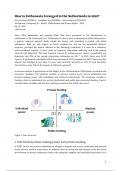How is Euthanasia Arranged in the Netherlands in 2050?
Iris van Hese (2726833) - Annefleur Arp (2663896) - Yara Langeveld (2760223)
Workgroup 3/subgroup 10 - Health, Globalisation and Human Rights - MPA
08/12/2023
1,000 words
Since 2002, euthanasia and assisted death have been permitted in the Netherlands, as
established in the Euthanasia Act5. Euthanasia is when a doctor administers lethal substances to
a patient, whereas assisted death entails the doctor only providing a patient with lethal
substances. Both are still subject to Dutch criminal law, but are not punishable offences
anymore, provided the doctor adheres to the following conditions: 1) it must be a voluntary,
well-considered request, 2) there must be hopeless, unbearable suffering, and 3) the patient
must be well-informed4. The most frequent reasons for euthanasia are cancer, comorbidity and
dementia, and 75% of the people requesting euthanasia are 50+7,3. In 2022, there were 8,720
reports of performed euthanasia, which is an increase of 13.7% compared to 20217. Moreover, this
amount has doubled in less than 10 years and currently amounts to 5.1% of total mortality.
Nevertheless, only 29% of all requests in 2019 were granted3.
A scenario analysis is performed on this subject in the Netherlands in 2050 based on political and
economic variables. The political variable is decision-making power and is subdivided into
decision-making power with individuals and medical professionals. The economic variable is
funding, which is subdivided into private (individual) and public (governmental) funding. Figure 1
contains these variables and the four resulting scenarios that will be discussed.
Figure 1. Four scenarios
I. Individual decision-making power and private funding
In 2050, Dutch law permits individuals of all ages to request and receive euthanasia and assisted
death without medical restrictions. In addition, they are privatised and outsourced by the Dutch
government to private euthanasia clinics with adequate supplies and specialised personnel. As a
1





